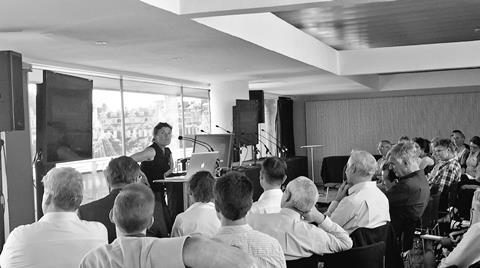Architectural historians, conservationists and the wider architectural community pay tribute to Elain Harwood

Tributes are being paid to Elain Harwood, the leading architectural historian and heritage professional, who has died at the age of 64.
Catherine Croft, director of the Twentieth Century Society said:
“We’re in shock at the sudden death of our beloved Elain Harwood (1958-2023). She was one of my best friends, and got me involved in C20 in my early 20s.
“Elain was the soul of the Society for so many decades and remained at the very centre of our work; vigorously leading tours in the UK and abroad, writing and editing books, and organising innovative lectures and conferences. Her unrivalled expertise, enthusiasm and generosity touched each and every one of us. She was unfailingly generous with her knowledge and inspirational supportive to both professional scholars and amateur enthusiasts.
“I have the most enormous love and admiration for everything she has done. Her life’s work was the study and celebration of our twentieth century architectural heritage, and her legacy will be incomparable.
“She was also enormous fun and seemed inexhaustible – I can’t believe she is no longer with us.”
RIBA President Simon Allford said: “I am deeply saddened to learn of the passing of esteemed architectural historian Elain Harwood.
“Elain was a great friend to architecture, architects, and my own practice. She was an inquisitive and intelligent historian and engaging and enthusiastic supporter of architectural discussion. I know this first hand as she generously delivered many uniquely engaging tours and lectures to and at AHMM over the years.
“I was therefore delighted to be able to recognise her as a 2022 RIBA Honorary Fellow for her work championing threatened buildings and for her expertise on post-war English architecture. Elain’s contribution to the profession and architectural literature are invaluable, and her presence will be sorely missed.
“I’d like to extend my condolences to her loved ones and those who had the privilege of working alongside her.”
Elizabeth Darling, chair of the Society of Architectural Historians of Great Britain, said: “It is with immense sadness that the SAHGB has learnt of the sudden death of Elain Harwood. She was a leading historian of twentieth-century British architecture, with an extraordinary depth and range of knowledge which she shared generously and with such vitality and enthusiasm.
“A lecture or study tour given by Elain, many for the Society, was always a memorable experience, brought to life by her deep understanding of architecture and her storytelling skills. Her scholarly work as senior architectural investigator at Historic England has been central to the revaluation of post-war British architecture.
“This work was perhaps best embodied in her magisterial book, Space, Hope and Brutalism, an encyclopaedic study of British architecture from the 1950s onwards, for which the Society awarded its most prestigious prize, the Alice Davis Hitchcock medallion in 2016.
“For those of us used to seeing her poring over copies of the Architectural Review at the British Architectural Library, it is very strange to think that we shall not see her again. Her contributions to architectural history and architectural heritage are immeasurable and her loss will be deeply mourned.”
Henrietta Billings, director of SAVE Britain’s Heritage, said: “What a huge loss. Elain’s knowledge, intellect, passion, and enthusiasm for twentieth century architecture and design was unparalleled, as was her gift for communicating it to wide audiences.
“The rising levels of public interest in brutalism and other previously unloved periods of modern architecture are largely down to her – through the many books she has written, countless sell-out tours she has led and talks she has given. This will be her enduring legacy and it is up to all of us to carry on her incredible work.”
Jon Wright, a former Twentieth Century Society caseworker said: ”Elain Harwood was awesome. There can be no greater testimony to her memory than the legacy of over 1,000 Post-War buildings now on the national list – many of them noted and investigated by her before anyone else - and the library of books she wrote on the architecture of the 20th Century.
“Her generosity with what she found out and stored in her unbelievable memory banks was astounding and she wore an impressive intellect with charm and fun. Irascible, irrepressible and completely wonderful, Elain was just completely unique. Her death is a huge loss for architecture and architectural history.”
Former RIBA President Ben Derbyshire said: “My voice alone would be nowhere near enough to do justice to Elain Harwood and her unique contribution to twentieth century architectural heritage. Others have known her longer and better than I. I met her in her role as Senior Architectural Researcher for Historic England and that encounter was enough to convey the truly remarkable sense of history that she brought to her work.
“We were in Portsmouth with the Historic Places Panel where Elain led us on a guided tour of the post war reconstruction; the Central Library, Guildhall and Commercial Rd. She brought the architecture alive, taking us back to the circumstances in which buildings were commissioned, relationships between the architects and their patrons, their provenance and influences – bringing us along with such spirit and enthusiasm.
“Everyone who witnessed this wore a permanent smile as the zeitgeist of confident mid-century rebuilding was brought to life. We saw the clean modern lines of buildings, spaces, and their proud civic purpose with fresh eyes.
“Our walk ended at the site of the long-demolished Tricorn Centre, now a gaping hole in the urban landscape given over to parking. Elain enthused about its brave architecture and little-known mixed-use programme even as passers-by heckled their disdain.
“Her positive critical assessment of Owen Luder’s oeuvre seemed entirely characteristic of her brave career. Afterwards she set off under leaden skies to collect her bike for the train journey home and now we know we shall never see her again. So sad.“
Christine Manning, a friend since school, said: “Elain Harwood and I met at Bramcote Hills Grammar School. Our friendship started in our teenage years, when we studied several subjects together. She was very intelligent, but also had a rebellious streak.
“Back in the days when it was still acceptable for teachers to throw chalk at their pupils, she was the only one of us who dared to throw it back. She was enthusiastic and curious about life, and she encouraged our teenage explorations of art, music, and everything Nottingham had to offer a teenager in the seventies.
“At the start of our working lives we both found ourselves in London. Elain’s career started as an assistant at the Record and Tape Exchange, and she loved working in its buzzing atmosphere. She then began a career in the Civil Service, but found it hard to work with the departmental ethos, which was joyless and alien to her. This was the only time when she seemed less than enthusiastic about life.
“Fortunately, she transferred to English Heritage, where her love of life was rekindled. She researched the history of buildings and discovered a love for architecture. She was finally free to put her enthusiasm and curiosity to good use, and was understandably proud of having achieved her ambition to be a Buildings Historian.
“I am sure that Elain will be missed professionally. As a friend, I will miss her sense of adventure and fun.”
Architectural historian Otto Saumerez Smith said: “No one will ever see more, or know more about, post-war architecture than Elain Harwood - it would be impossible. Tragic for my discipline and the Twentieth Century Society.”



















No comments yet